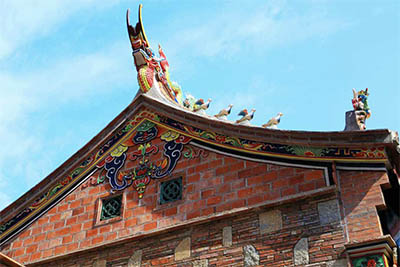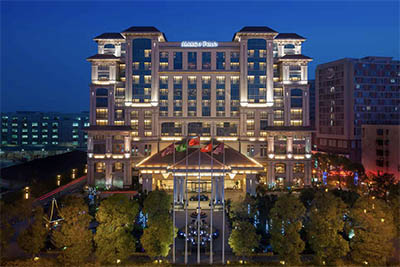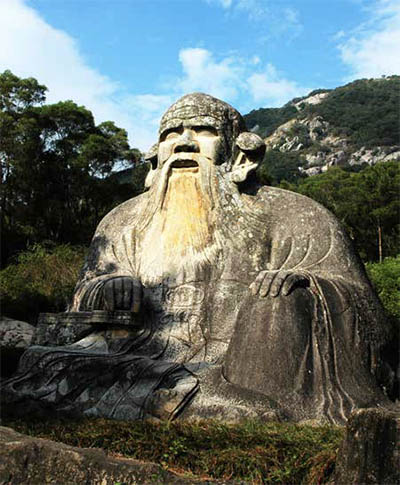IN THE LATE 13TH CENTURY on the southeast coast of China, a Venetian merchant arrived at a vast bay muddied by the outflow of two great rivers, the Jin and the Luo Yang. The man was Marco Polo, an experienced traveler who traded his way across Europe and Asia. It was a well-worn route. European merchants came to China to procure silk, tea, salt, sugar, spices and porcelain. They brought with them gold, silver, ivory, wool and wine.
By the time Marco Polo reached the coast, he had traded at many centers along the fabled Silk Road, but here he found a place that, thanks to strategic good fortune, stood out. The bay provided safe mooring for vessels from all over Asia and beyond, while the two major rivers afforded access to the Chinese interior. When the Venetian later wrote his famous account of his travels, he declared this spot to be one of the “greatest havens in the world for commerce.”
Over subsequent centuries, China became more insular, international trade withered, and the area’s fortunes waned. Yet the geographical advantages were unchanged, giving rise to four cities: Jinjiang, Quanzhou, Nan’an and Shishi. They retain their distinct identities, though they have long since sprawled into one another, and from the air on approach to Quanzhou Jinjiang International Airport it is not easy to distinguish where one ends and the next begins. Administratively, Jinjiang, Nan’an and Shishi are county-level cities, while Quanzhou is the senior prefecture-level city.
In some respects, Jinjiang is where the modern Chinese economic miracle started. In the 1970s, when the country’s Communist leadership made its first cautious experiments with private enterprise, Jinjiang was the guinea pig. The “Jinjiang Model” encouraged small businesses to thrive, and local per capita incomes rapidly rose to nearly three times the national average.

Jinjiang features South Fujian architecture © IVAN SINAYKO | DREAMSTIME.COM
Jinjiang’s modern success was built on modest factories producing food, clothing and shoes. The economic boom transformed the cityscape. As you’d expect of a Chinese industrial city, Jinjiang has become a forest of high-rise apartment blocks and industrial zones threaded through with multi-lane highways. And yet unlike cities such as Beijing and Shanghai, which swept away much of their architectural fabric in the march forward, Jinjiang simultaneously managed to conserve its traditions.
In part that is due to strong family ties to the ancestral past. Scattered throughout the city you’ll find clan temples preserving the heritage of individual families. Within these ancient shrines the modern city recedes, and you are immersed in the sights, sounds and scents of another time.
The preservation of the past is taken to extremes in Wudianshi (Five Shops District) in the heart of Jinjiang. Here, hedged by ranks of skyscrapers, hundreds of Song and Ming Dynasty buildings dating back 600–1,000 years have been translocated and rebuilt. The result is a photogenic cluster of low-rise, tile-roofed houses and temples that give a vivid sense of the city as Marco Polo would have known it.
As a port, Jinjiang is inherently outward-looking. This was one of the main departure points for the Chinese diaspora, and today hundreds of thousands of people of Chinese origin living around the world regard this city as their ancestral home.
But that is only part of the story. Jinjiang has been defined as much by immigration as emigration. The Ding clan arrived from Persia 800 years ago, bringing Islam with it. Christianity and Hinduism also have deep roots here. The city’s most precious symbol of religious diversity is situated on Huabiao Mountain, west of downtown. Here, nestling amid trees, is the Cao’an Temple, dating back to the ninth century. Although it superficially appears to be Buddhist, it is, in fact, the world’s only surviving Manichean temple, a valuable relic of a Middle Eastern religion that was persecuted to extinction more than a thousand years ago.
Despite its wealth of historic sites, Jinjiang has largely been bypassed by international tourism, though not by international business. The trading culture runs deep, and in the past three decades the city has established itself as a global hub for the manufacture of sportswear and sneakers. It isn’t all aboveboard. Alongside the famous brands, Jinjiang’s small factories also churn out cheap knock-offs: Mike sneakers; Abibas duffel bags.

Marco Polo Jinjiang exterior © WHARF HOTELS
But recently a new Jinjiang threat emerged to the global domination of Western sportswear brands. Anta, a brand headquartered in Jinjiang, invested heavily in design and marketing and is the official sponsor of boxer Manny Pacquiao and basketball star Klay Thompson, among others. Anta’s bird-like, sweeping logo is indicative of a city aspiring to reach new heights.
Marco Polo was one of the first outsiders to recognize Jinjiang’s potential, though he was not without criticism. “Neither grapes nor wine are produced here,” he wrote. “But very good raisins are brought from abroad, and wine likewise.” Trade is the way of life in Jinjiang, and local businessmen have no qualms about toasting their export successes with the finest imported wine.

© KATRINA YU
CHECKING IN WITH KATRINA YU
Asia Correspondent, SBS World News
What cultural differences should American investors be aware of when doing business in China?
The concept of “face” is key when traveling to China for business. It’s a difficult concept to grasp, but it primarily represents a person’s reputation and status within different spheres of life such as business, family, friends and so on. The main thing to be conscious of is maintaining a certain level of respect — or even formality — when it comes to business dealings and avoiding public/ group confrontations that might embarrass a member of a Chinese team or cause them to lose face. Another key difference is that business cards are king. Often people will exchange them on first meeting. They should be given and received with two hands and considered thoughtfully before being carefully put away — not crammed into a pocket!
How does Jinjiang compare to other Chinese cities?
Jinjiang is a relatively small city but with a bustling business/manufacturing industry. Compared to other cities in China, it’s been less exposed to Western visitors and culture. This is not to say it’s not exposed to other cultures. People from Jinjiang have been traveling around the region and returning over the past few decades, bringing stories, tastes and sensibilities from other countries in Asia. Jinjiang also embraces aspects of traditional Chinese culture the south of the country is known for. For example, partaking in tea-drinking ceremonies, doing calligraphy or ink-painting and the celebration of poetry still seem to be actively embraced by people of all generations, while some of these things are less popular in major urban centers such as Beijing.
Many people in the Chinese diaspora, yourself included, trace their ancestry to Jinjiang. To what extent do those overseas family connections impact the city?
For a small southern city Jinjiang is relatively prosperous, with a bustling manufacturing industry, thanks to the traveling entrepreneurial nature of many in the community. Many family members who left Jinjiang to look for better lives or opportunities returned to begin businesses or sent money back to their families. Also, it’s common to speak to someone in Jinjiang who has had at least one relative migrate or spend time overseas in the Philippines, Malaysia, Singapore, etc. Because of this there’s a deeper understanding of these cultures among local Jinjiang people.
What attractions would you recommend in Jinjiang and the surrounding area?
For solid understanding of Jinjiang’s culture of migration, I recommend the Migration Museum. It’s close to Jinjiang’s city center and offers free entry. It houses exhibitions on Chinese emigration and the origins of China’s global diaspora. From enduring terrible treatment as exploited workers to becoming successful settlers and businesspeople, it tells a fascinating story of the millions of overseas Chinese and the active communities around the world which maintain their Chinese identity, language and culture.
Five Shops District, or Wudianshi, is great for a relaxing cultural stroll. This pedestrian compound contains more than 100 lovingly relocated and refurbished historical buildings from the Song and Ming dynasties. According to legend, during the Tang Dynasty there were five shops and restaurants in Jinjiang that were so well-run and served such excellent cuisine that they made the area famous. Today visitors to Five Shops District can experience ancient architecture while sipping tea or shopping for antiques.
DIVERSIONS
Can you be in a metropolitan region with a population of 8 million while simultaneously being off the beaten path? During a visit to Jinjiang and neighboring Quanzhou, you will conclude: Yes, you can.
There is little in the way of international tourism here (the vast majority of foreign arrivals have ancestral connections to the region), and the population of expatriates is in the hundreds at most, as opposed to the tens of thousands residing in Shanghai, Beijing or Hong Kong.
The Cao’an Temple on Huabiao Mountain is the must-see for history enthusiasts. The only surviving building of the long-lost Manichean religion, it pre-dates Marco Polo’s visit by several centuries.
For a sense of the trading port Marco Polo encountered in the 13th century, cross the River Jin to Quanzhou and visit the excellent Maritime Museum. Exhibits include ancient artifacts and many scale models of sailing vessels. Signage is in English as well as Chinese. While in Quanzhou, be sure to visit the Kaiyuan Temple, another architectural relic Marco Polo would recognize today. It dates back to 686; and although it is a Buddhist site, it incorporates elements of a Hindu temple constructed in the 13th century by the local Tamil population. Towering over the sprawling, leafy grounds are two intricately carved, five-story stone pagodas.

Giant statue of Laozi © TSANGMING CHANG | DREAMSTIME.COM
For a rural diversion, head into the wooded, hilly hinterland behind Quanzhou to visit an ancient stone sculpture of the fifth-century Chinese philosopher Laozi (also known as Lao- Tzu), the founder of Taoism. The statue, carved from natural rock, is interesting in itself, but a visit also provides a green, peaceful respite from the hectic swirl of urban life. If you have the time, hiking trails beyond the sculpture ascend the forested slopes of Qinyuan Mountain, with great views along the way.
Alternatively, head in the other direction and escape to the coast. Jinjiang’s neighboring city, Shishi, boasts more than 40 miles of coastline, including broad, sandy beaches. The prime resort is the Gold Coast, an extensive complex including hotels, an aquarium and shopping mall. Sightseeing boat trips offer an offshore view of this fascinating corner of southeast China.
Jinjiang Info to Go
Flights arrive at Quanzhou Jinjiang International Airport, five minutes by taxi from downtown Jinjiang. The airport is served by domestic flights from several major Chinese cities (including Hong Kong), and international flights to Thailand, Japan, Singapore and the Philippines, among others. The city is also connected to the high-speed Fuzhou-Xiamen Railway, which links the major cities along the coast of Fujian Province.
Jinjiang: Just the Facts
Time zone: GMT +8
Phone code: Country code: 86 City code: 595
Currency: Renminbi (aka yuan)
Key industries: Manufacturing, import-export
COMING AND GOING
All U.S. citizens require a passport valid for at least six months beyond arrival and a valid visa. Ten-year multiple entry visas are available. It is essential to ensure your paperwork is in order prior to traveling to China. Any discrepancy could result in a fine and deportation.
OFFICIAL LANGUAGE
Mandarin Chinese is widely spoken, though the most common first language is Minnan.
Where to Stay in Jinjiang
GRANDLINK HOTEL This large, palatial hotel in the southern part of the city includes a gym, indoor swimming pool and tennis court, plus meeting rooms. North Haiba Road, Anhai Town $$
MARCO POLO JINJIANG This modern hotel managed by Hong Kong-based Marco Polo Hotels caters primarily to domestic business travelers. Not all of the staff speak English. Sunshine East Street, Qing Yang Town $$$
WYNDHAM JINJIANG Located close to the economic zone, this high-rise hotel (formerly the Ramada Plaza) offers international comfort and familiarity. 1 Yuandong Ave., Economic Development Zone $$$
Restaurants in Jinjiang
DD TEPPANYAKI BANKER’S CLUB The Japanese restaurant featuring a teppanyaki grill opens daily for lunch (11:30 a.m.–2:30 p.m.) and dinner (5:30–11 p.m.). Marco Polo Hotel, Sunshine East Street, Qing Yang Town $$$
LITTLE SHEEP HOT POT With several outlets in the city, the popular Chinese chain offers all-you-can-eat, make-it-yourself Mongolian one-pots. Select ingredients and cook at your table. Jinxi Road; Changxing Road; Xinshun Street $
TEPPANYAKI RESTAURANT Belying the Japanese name, the Wyndham’s fine-dining restaurant offers French cuisine and a decent wine list. Not to be confused with the restaurant at the Marco Polo. Wyndham Hotel, 1 Yuandong Ave., Economic Development Zone $$$
Read This Next
Wine Tasting in the Finger Lakes
August 2017
Aug 1, 2017All Reads on This Topic
Read Them All

Introducing
FX Excursions
FX Excursions offers the chance for once-in-a-lifetime experiences in destinations around the world.
#globility
Insta FeedDaily
Jan 17, 2025Michelin-Starred Chef Rolls Out New Menu at Albert Hotel in Fredericksburg, Texas
MICHELIN-starred Chef Michael Fojtasek, whose accolades include three times as a James Beard finalist for Best Chef: Southwest, introduced his seasonal menu at The Restaurant at Albert Hotel. Local ranchers, farmers and food artisans representing the Texas Hill Country region are showcased in dishes including Raw Gulf tuna with grilled kabocha, benne seed, black butter and fumet; red snapper with smoked trout roe and fennel fumet; and peach-blackberry crostata with crème fraîche whip.
Sponsored Content
Extraordinary Egypt
ONCE-IN-A-LIFETIME JOURNEY INTO THE ANCIENT WORLD OF THE PHARAOHS
Daily
Jan 17, 2025Dorado Beach, a Ritz-Carlton Reserve Goes Big for Valentine’s Day
This Valentine’s Day, skip the traditional gift and give the gift of travel and lifelong memories with a romantic getaway to Dorado Beach, a Ritz-Carlton Reserve. Thanks to its beautiful weather, delicious dining options, stunning scenery and relaxing wellness offerings, this property offers a one-of-a-kind escape for couples.
Daily
Jan 17, 2025Anantara Bophut Koh Samui Resort Unveils Newly Refurbished Guestrooms
Following a four-week renovation, Anantara Bophut Koh Samui Resort recently unveiled its newly refurbished guestrooms, furthering the resort’s commitment to offer one of the most luxurious guest experiences on the island. Next up, the resort will introduce a new Kids and Teens Club and state-of-the-art Technogym fitness facility later in 2025.
Sponsored Content
Madrid: The Charm of an Authentic City
They say Madrid is in vogue for many reasons: its lifestyle, its heritage, its cuisine and all of its new attractions. And it’s true, because Madrid is on the radar of travelers looking for a cutting-edge destination that still holds onto its essence. Join us as we explore its charms.
Daily
Jan 16, 2025Get a Glimpse Into One of the Busiest Transportation Stations in Europe: Roma Termini
Rome's Termini Station is a true icon of modern Roman architecture, serving as the city's largest rail station and one of Europe's major transit centers. One of the key aspects of the structure’s recent transformation was opening up the view toward the sixth century B.C. Servian Walls from the main hall, restoring visitors' visual connection to this historical legacy.
W Hotels Opens First Property in Brazil
Daily
Jan 15, 2025eFlyer News
Jan 15, 2025Uber to Be Exclusive Rideshare, Delivery Partner of Delta Air Lines
Beginning this spring, Uber will be the exclusive rideshare and delivery partner of Delta Air Lines. This new, multiyear partnership allows SkyMiles members to earn miles when riding with Uber and ordering with Uber Eats throughout the United States.
Sponsored Content
Sailing the Ionian Sea: Explore Greece’s Nautical Gems
Sailing the Ionian Sea is an enchanting way to experience Greece's breathtaking islands and pristine waters. Known for its favorable winds, calm seas and stunning landscapes, the Ionian Sea offers a paradise for both experienced sailors and those looking to explore for the first time. From lively beaches to secluded bays, these waters have something for every traveler seeking adventure and relaxation.
eFlyer News
Jan 15, 2025Mandarin Oriental to Sign 2 European Hotels
Mandarin Oriental Hotel Group announced the expansion of two iconic hotels: Conservatorium Hotel in Amsterdam and Hôtel Lutetia in Paris. Following the completion of the transaction with relevant Works Councils, both properties will be rebranded, with Hôtel Lutetia transforming to Mandarin Oriental Lutetia, Paris, and Conservatorium Hotel changing to Mandarin Oriental Conservatorium, Amsterdam.
ShareThis